What Is the Justice40 Initiative?
This Biden administration directive is the historic effort to ensure that federal climate, clean energy, and infrastructure investments reach the communities who need them most.
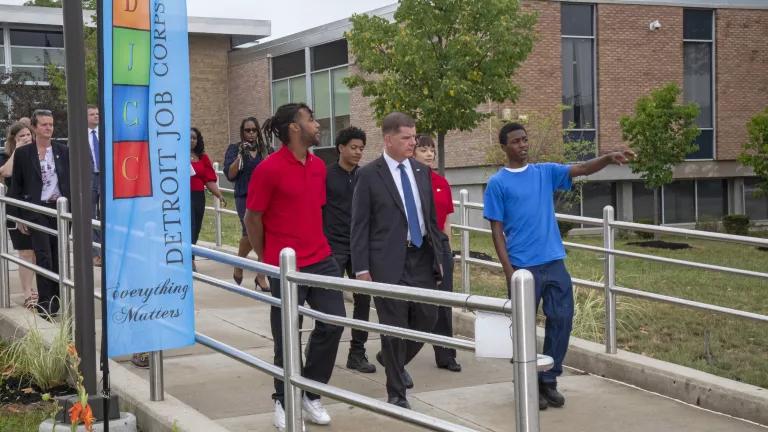
U.S. Secretary of Labor Marty Walsh (front, center) visiting the Detroit Job Corps Center, which is one of the many programs receiving benefits for specialized training under the Justice40 Initiative
Department of Labor/Jim West
Tackling climate change will require an ambitious policy and billions in federal funding that, if done right, will create a wealth of benefits—like cleaner air, quality jobs, economic growth, stronger public health safeguards, and modernized infrastructure that better serves future generations. But in order to be successful, these benefits need to reach everyone, particularly the frontline communities who’ve long borne the brunt of environmental and climate harms. The Justice40 Initiative, the Biden administration’s historic whole-of-government approach, is a critical step to ensuring this happens.
Passed as part of Executive Order 14008, just days after President Biden took office, Justice40 requires that at least 40 percent of the overall benefits from federal climate and infrastructure investments go toward disinvested and overburdened communities. Here’s what you should know about the initiative and its ongoing implementation, nearly three years after it was signed.
Why was the Justice40 Initiative necessary in the first place?
Across the country, low-income communities and communities of color experience the greatest environmental and climate impacts, ranging from more polluted air to higher safety risks during extreme storms. And yet these same communities are often overlooked by decision makers when they are considering where to make on-the-ground investments.
This is not an accident: Discriminatory policy decisions have routinely prioritized wealthier and whiter communities at the expense of the health and well-being of underserved communities. This pattern is what led to the birth of the environmental justice movement and continues to motivate the work of tireless advocates across the country. The Justice40 Initiative recognizes the need for an intentional, comprehensive approach to ensuring that no community gets left behind as we build a clean energy future. “Justice40 starts to right these historical wrongs,” says Mikyla Reta, an NRDC community solutions advisor. “It's an ambitious goal, and at the same time, it’s not enough.” Beyond the need for much more funding of programs aimed at benefiting communities facing multiple barriers, a deeper push for equity must be coupled with stronger regulations specifically targeting climate and environmental injustices.
What falls under the Justice40 Initiative?
Justice40 applies to any federal investment (including programs, grants, and loans) that fits within one of these seven categories:
- Climate change
- Clean energy and energy efficiency
- Clean transit
- Affordable and sustainable housing
- Remediation and reduction of legacy pollution
- Critical clean water and wastewater infrastructure
- Training and workforce development related to these investment areas
This wide net means that more than 400 new and existing federal programs—including many created by the Inflation Reduction Act and the Bipartisan Infrastructure Law—across two dozen federal agencies now fall under the Justice40 umbrella. And all must take steps to meet the required 40 percent benchmark.
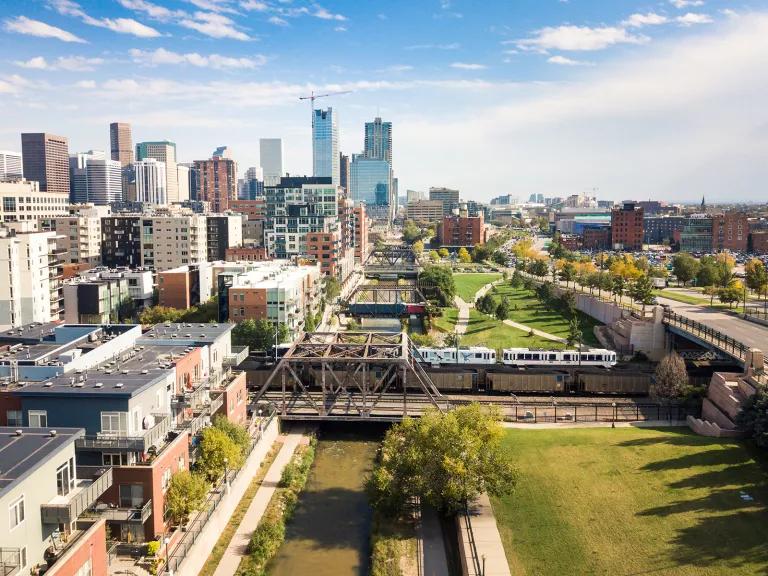
Denver’s RTD light rail offered zero-fare rides as a part of its Zero Fare for Better Air initiative. Transit initiatives like this one are now eligible to receive funding when applied for under Justice 40.
Regional Transportation District (RTD)
Who will benefit from the Justice40 Initiative?
Determining which communities qualify for Justice40 benefits has been central to the initiative’s implementation. In 2022, the White House Council on Environmental Quality (CEQ) released the first version of its Climate and Economic Justice Screening Tool to help federal agencies do just that.
According to the publicly accessible tool, Justice40 communities are defined as low-income census tracts (where more than 65 percent of households are at or below twice the federal poverty level) that also experience at least one other environmental, economic, or health burden, such as a high level of particulate matter in the air or an increased flood risk. All federally recognized tribes also fall under this umbrella. Using these metrics, nearly 29 percent of the U.S. population qualifies.
The tool allows a user to view a region’s “burdens” by category—such as legacy pollution, transportation (taking into account high levels of diesel exhaust and barriers to public transit access, for example), and housing (like high costs or lack of green space). It doesn’t, however, rank or consider cumulative burden. It also excludes race as an explicit criteria, although environmental racism is often at the root of such inequities.
What benefits will the Justice40 Initiative bring?
The benefits from Justice40 will be diverse, wide-reaching, and ideally in alignment with what communities themselves report that they need most, which will require ongoing, meaningful consultation with residents. Climate and infrastructure investment targets include: improved public transportation, electric vehicle (EV) charging networks, drinking water safety, extreme heat response plans, and clean energy job training programs.
This intentionality in considering environmental and racial equity is particularly important as the country transforms entire sectors, like power and transportation, in order to tackle climate change. “Many of these new technologies have not been implemented to scale,” says Batoul Al-Sadi, an NRDC equity advocate. For example, currently, most of the nation’s public EV chargers remain clustered in areas where wealthy, predominantly white, early adopters live. “We have to make it a priority for frontline communities to not only be informed of projects but actually brought into the planning process,” Al-Sadi says, “while also ensuring that the negative impacts of a project don't disproportionately harm environmental justice communities, as they have historically.”
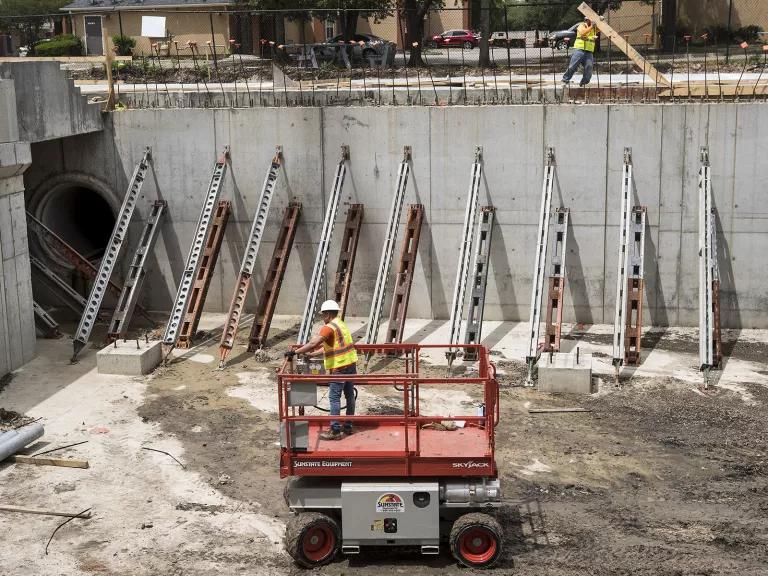
An underground detention vault being built in the parking garage of the Blackwell Medical Center apartments in Houston, which will help mitigate flooding in the area
Brett Coomer/Houston Chronicle via Getty Images
How is implementation going?
In addition to the rollout of the screening tool and the designation of the relevant programs, some progress can already be seen. Justice40 policies have spurred the electrification of tribal government buildings, new research on flood mitigation, and increased funding to address the threat of lead paint in homes.
But far more work is still ahead. While the White House Office of Management and Budget provided initial implementation guidance in 2021, directing federal agencies to identify the benefits of their programs and figure out a methodology for reaching their 40 percent goal, each agency’s status has yet to be made public. The one exception is the 2023 Environmental Justice Scorecard, which presented a high-level assessment of the progress that federal agencies made in 2021 and 2022. Effective implementation will require more transparency and frequent feedback from the administration, Reta says, as well as more opportunities for ongoing stakeholder engagement.
Because there is no single organizing body behind Justice40—officials from the CEQ, the White House Environmental Justice Interagency Council, and the White House Environmental Justice Advisory Council all work jointly—there is room for additional state leadership. To this end, a number of state legislatures have taken up bills that would establish local oversight committees and help direct Justice40 funds to the right communities. In states with legislatures unlikely to pass such bills, cities and counties may opt to pass their own Justice40 legislation.
“It has to be implemented from the federal government all the way down to the community to which it's going,” Reta says, “and equity has to be ingrained in every single step of that process.”
This NRDC.org story is available for online republication by news media outlets or nonprofits under these conditions: The writer(s) must be credited with a byline; you must note prominently that the story was originally published by NRDC.org and link to the original; the story cannot be edited (beyond simple things such as grammar); you can’t resell the story in any form or grant republishing rights to other outlets; you can’t republish our material wholesale or automatically—you need to select stories individually; you can’t republish the photos or graphics on our site without specific permission; you should drop us a note to let us know when you’ve used one of our stories.
Millions of Americans drink tap water served by toxic lead pipes.
Tell the EPA we need safe drinking water!
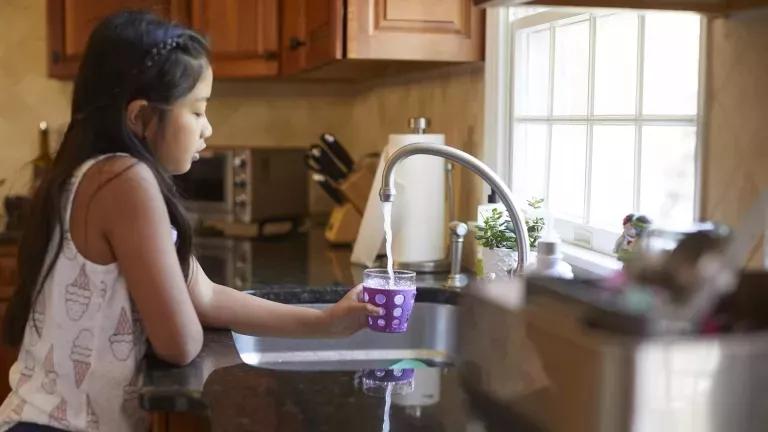
Tell the EPA we need safe drinking water!
There is no safe level of lead exposure. But millions of old lead pipes contaminate drinking water in homes in every state across the country. We need the EPA to do its part to replace lead pipes equitably and quickly.

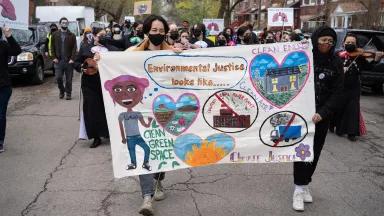
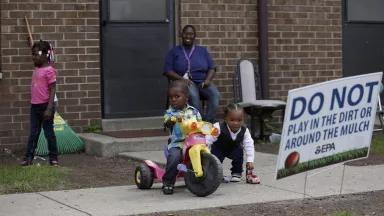
Indoor Workers Need Protection from Extreme Heat Too
What Are the Effects of Climate Change?
Mutual Aid and Disaster Justice: “We Keep Us Safe”